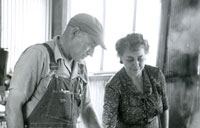
Aline Hazard was the longtime host of the Homemaker Program on Wisconsin’s College of the Air. The show aired for 32 years, from 1933 to 1965, broadcasting 6 days a week, chocking up over 10,000 broadcasts. It achieved nationwide prominence, and won broadcasting awards including the American Association of Agricultural Editors Award, and the Wisconsin Federation of Music Club prize.
Aline Hazard graduated from Grinnell College in 1918 with a degree in Speech and English. For three years she worked as a High School teacher, instructing English, Latin, Physical Culture, and Speech classes. Following secondary teaching she moved to Peking, China and taught English at Tsing Hua University for three years. She moved to Madison in 1932 to earn a BS in Home Economics while working full-time for the Agricultural Journalism department and supporting two young children on her own. In 1933, Hazard’s supervisor, Professor Kenneth Gapen, suggested she audition for the announcer position on the newly created home economics program on WHA. Hazard got the job and was provided a graduate journalism student named Ruth Milne to assist her with daily show preparation. She received her UW BS degree in 1940.
Broadcasts began on June 20, 1933. According to Hazard’s autobiography For the Love of Mike, still extant in the Wisconsin Historical Society archives, the Homemaker’s Hour was ‘built around home extension projects and related to homemaking interests and activities’. An ‘extension project announcement’ from 1936 further reported that show subjects regularly related to ‘needs of homes, interests of women, desires of many, with contact to homemakers groups, federated women’s clubs, music clubs, garden clubs, and university departments’. Hazard would travel to and broadcast from a multiplicity of Wisconsin domestic and agricultural sites, and over the years she hosted almost every type of guest associated with the broad topic of hearth and home.
Among Hazard’s regular guests was Stella Patton, Professor of Foods and Nutrition. Patton later related that her first appearance on the Homemaker’s Hour caused quite a stir. “Because it was an occasion of note, her sister Mary braved the storm and despite the weather reached a friends home where a crystal set with headphones was available. Mary heard her sister’s voice with awe, little realizing that for more than 30 years Patton would continue her helpful radio talks on food.” (For the Love of Mike, 7). Another frequent guest was Gladys Meloche, a professor of home economics. Meloche herself made a few home economics broadcasts in 1921 before becoming a regular guest on the Homemaker Program, potentially making Meloche the first to ever broadcast on the subject.
Hazard later recalled that in the early days one 16 by 19 foot room sufficed for all programs—with people wandering around the studio during broadcasts. Harold McCarty sat outside the room on most days. Often, in the beginning, speakers wouldn’t arrive, and if this was the case, McCarty—a trained musician and actor—would jump in with a short musical interlude to ‘save the day’. But soon enough the show accumulated a large group of listeners. By 1936 more than 4900 homemakers asked to be sent advanced printed program schedules in order to be informed on forthcoming shows, topics of which covered dozens of subjects ranging over the years from: foods, textiles, health, travel, book reviews, crafts, child welfare, seasonal facts, news, consumer helps, and recreation to beauty, law and business, school interests, vocations, gardening, 4-H Club, church, education, entertainment, poultry, landscaping, household, community activities, the PTA, nutrition, economics, music, art, and poetry. The show was so popular that in 1941 they received 1600 responses to a ten day egg and poultry contest.
The archives feature listener correspondence, a significant collection of recipes, ‘how-to’ scripts, annual reports, and other show preparation. Of particular note are her autobiography and an entire folder dedicated to honey, including documents pertaining to honey recipes, honey ‘projects’, bee keeping, and honeycomb uses.
Digital Documents
